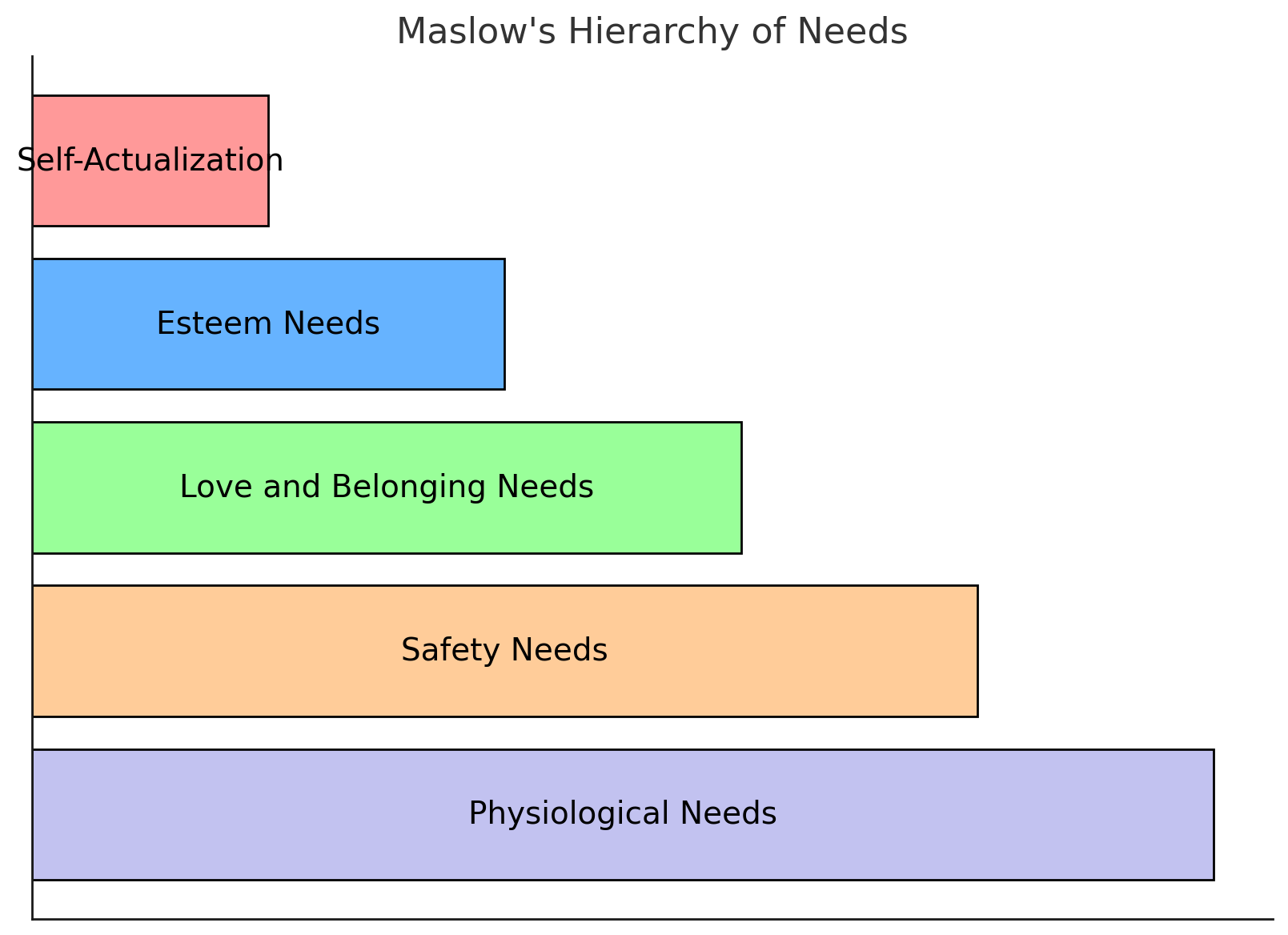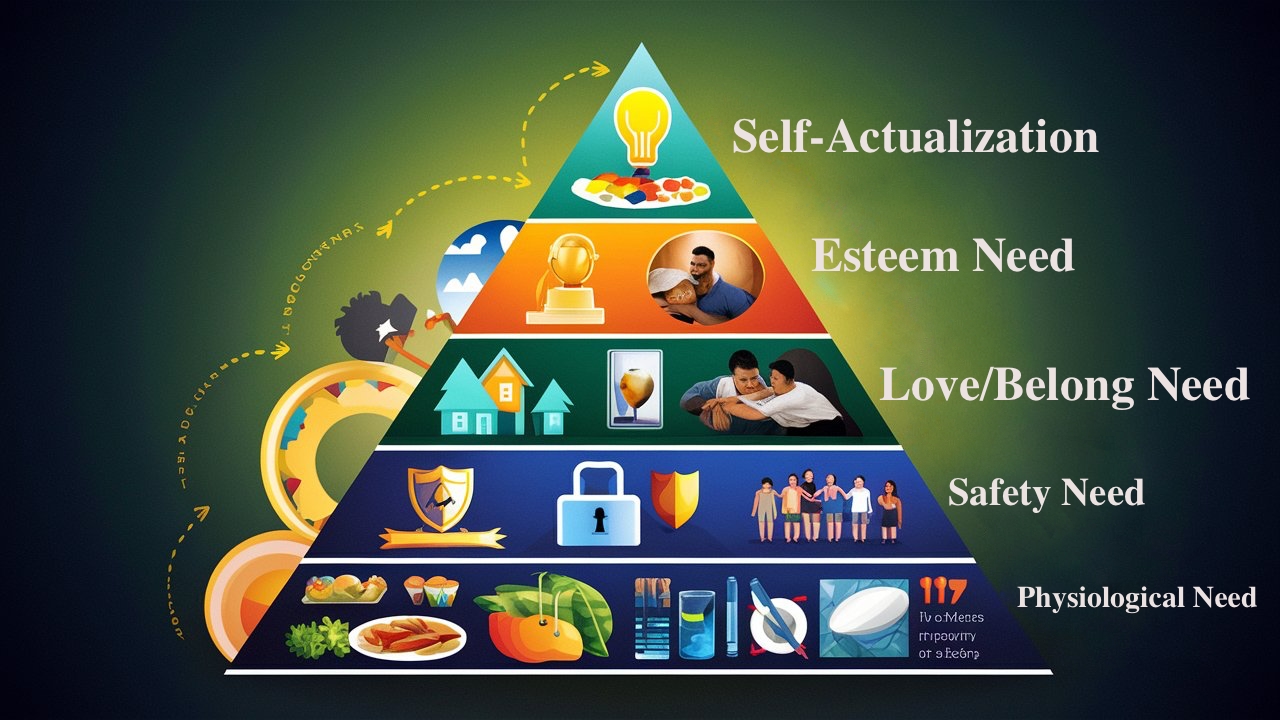Maslow's Hierarchy of Needs is a psychological theory proposed by Abraham Maslow in 1943. It is often depicted as a pyramid, with the most basic needs at the bottom and the more complex needs at the top. The theory suggests that people are motivated to fulfill basic needs before moving on to other, more advanced needs.
Imagine you are building a pyramid out of blocks. Each block represents a different type of need that humans have. The idea is that you need to satisfy the needs at the bottom before you can move up to the next level.
Here are the five levels of the pyramid:
- Physiological Needs: These are the most basic needs for our survival. Think of things like food, water, air, and sleep. Without these, we can't live.
- Safety Needs: Once our basic survival needs are met, we need to feel safe. This includes having a home, staying healthy, and being protected from danger. It's like needing a safe place to live and not being afraid.
- Love and Belonging Needs: After feeling safe, we want to have friends and family. We need to feel loved and accepted by others. Imagine having good friends, being part of a team, or feeling that your family cares about you.
- Esteem Needs: Next, we want to feel good about ourselves. This means having self-respect and feeling valued by others. It’s like doing well in school or sports and being proud of your achievements.
- Self-Actualization: This is the top of the pyramid. It's about realizing your full potential and becoming the best version of yourself. It’s like following your dreams and doing what you are really passionate about.
So, think of the pyramid like this: you need to take care of the bottom blocks first (like eating and being safe) before you can climb higher to make friends, feel good about yourself, and finally, do what makes you truly happy.

Here's a pyramid diagram of Maslow's Hierarchy of Needs. Each level represents a different type of need that we aim to fulfill, starting from the bottom and moving to the top:
- Physiological Needs: Basic needs like food, water, and sleep.
- Safety Needs: Feeling safe and secure, having a home and good health.
- Love and Belonging Needs: Friendships, family, and being part of a group.
- Esteem Needs: Feeling good about yourself, achieving things, and being respected.
- Self-Actualization: Realizing your potential and pursuing your passions.
The idea is that we need to satisfy the lower levels first before we can focus on the higher levels.
Maslow's Hierarchy of Needs can apply in a corporate or workplace setting with real-life examples:
- Physiological Needs:
- Example: Companies provide their employees with a comfortable working environment, including clean air, adequate lighting, access to water, and breaks for meals. If you're working long hours, having access to a cafeteria or snacks can help you stay nourished and focused.
- Safety Needs:
- Example: Organizations ensure that the workplace is safe and secure. This includes physical safety measures, such as fire alarms and ergonomic office furniture, and job security, such as stable employment and health insurance. Knowing that you have a steady job and that the company cares about your health and safety helps you feel secure.
- Love and Belonging Needs:
- Example: Companies encourage team-building activities, social events, and a collaborative culture. Having good relationships with coworkers, feeling part of a team, and having a supportive manager make you feel like you belong in the workplace. This can be fostered through regular team meetings, social outings, and a culture of open communication.
- Esteem Needs:
- Example: Employees are recognized for their hard work and achievements. This can include promotions, bonuses, awards, and public acknowledgment of a job well done. Being given responsibilities and the opportunity to contribute ideas also boosts self-esteem. For instance, an employee might receive an "Employee of the Month" award or a bonus for meeting sales targets.
- Self-Actualization:
- Example: Companies provide opportunities for personal and professional growth. This includes offering training programs, opportunities for career advancement, and projects that challenge and engage employees. Encouraging creativity and allowing employees to pursue their passions within their job roles helps them realize their full potential. For example, a graphic designer might be given the freedom to lead a major project that showcases their unique skills and creativity.